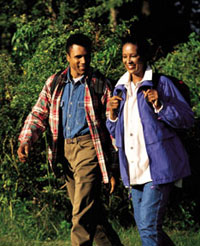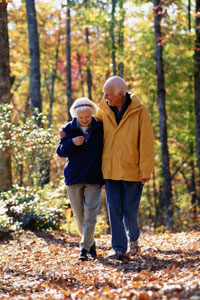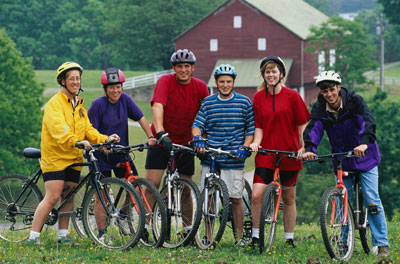|
|
|
|
|||||||||||
|
|
|||||||||||
|
|
Key Physical Activity Resources |
|
|||||||||
|
|
|||||||||||
|
|
|
||||||||||
|
|
|||||||||||
|
|
|||||||||||
Trails for Health
Increasing Opportunities for Physical Activity in the Community
|
The theme this year, Join Us on the Trail, is an open invitation to all Americans to join-up with a local hiking club, park and recreations, or federal land managing agency to get outside and enjoy the trials. |
Physical Activity: A Key Element
of Good Health
The evidence is more convincing than ever: people of all ages who are generally not active can improve their health through physical activity. Physical activity can help to
- Control weight.
- Control high blood pressure.
- Reduce risk for type 2 diabetes,
heart attack, and colon cancer. - Reduce symptoms of depression
and anxiety. - Reduce arthritis pain and disability.
- Prevent osteoporosis and falls.
Trails: A Fun Place to Be Active
 Although regular physical activity offers many health benefits, people
who are seeking ways
to become more active often overlook the opportunities that trails offer.
Trails can be found everywhere, from national and state parks to urban
areas. They provide a wide variety of ways to be physically active and
have fun:
Although regular physical activity offers many health benefits, people
who are seeking ways
to become more active often overlook the opportunities that trails offer.
Trails can be found everywhere, from national and state parks to urban
areas. They provide a wide variety of ways to be physically active and
have fun:
- Walking, jogging, running, and hiking.
- Rollerblading/in-line skating.
- Wheelchair recreation.
- Bicycling.
- Cross-country skiing and snowshoeing.
- Fishing.
- Hunting.
- Horseback riding.
- Canoeing or kayaking on water trails.
“Hitting the nation’s many trails and pathways is a great way for all
Americans to have fun and, at the same time, get some valuable exercise.”
Julie L. Gerberding, MD, MPH
Director, Centers for Disease Control and Prevention
U.S. Department of Health and Human Services
Taking Steps to Be More Active
 Overcoming common stumbling blocks to physical activity can help you
make physical activity a regular part of your life:
Overcoming common stumbling blocks to physical activity can help you
make physical activity a regular part of your life:
Not enough time? Start by doing 10 minutes of physical activity a day and
gradually work your way up to 30 minutes. Choose activities that require
minimal time, such as walking, jogging, or biking.
Can’t get motivated? Plan ahead. Make physical activity a regular part of
your schedule. Invite a friend to exercise with you regularly. Join a
group, such as a hiking or walking club.
No place to be active? Look around your community for inexpensive,
convenient places for physical activity, such as trails, parks, and
community centers.
No athletic skills? Choose physical activities such as walking that
require no new skills. You don’t need to be athletic to exercise.
How Much Is Enough?
Physical activity does not need to be hard to provide benefits. Adults should get at least 30 minutes of moderate-intensity physical activity (such as brisk walking) on five or more days per week, according to recommendations from the Centers for Disease Control and Prevention (CDC) and the American College of Sports Medicine.
"Families can improve their health and enjoy quality time together by
being active on our nation's many trails."
Michael O. Leavitt
Secretary, U.S. Department of
Health and Human Services
“Our nation's trails, parks, lakes, and rivers provide numerous
opportunities for recreation and physical activity. As manager of many of
these public lands, the Department of the Interior supports the
President's goal for a healthier and more active America.”
Gale A. Norton
Secretary, U.S. Department of the Interior
Related
Resources
American Hiking Society's "Hikers Info Center"*
CDC's Brochure, Trails for Health: Promoting Healthy Lifestyles &
Environments
Trails for Health is a Centers for Disease Control and Prevention (CDC)
initiative to help Americans of all ages achieve the health benefits of
physical activity by increasing opportunities for physical activity
and helping to make it an integral part of community life.
- English version
for a general audience
 (PDF-1.2Mb)
(PDF-1.2Mb) - Spanish version for a general audience
 (PDF-508K)
(PDF-508K) - Version for
policymakers
 (PDF-98K), also available in a
text-only version
(PDF-98K), also available in a
text-only version (PDF-83K)
(PDF-83K)
Environmental Change Strategies to Promote Physical Activity Quick Start![]() (PDF-74k)
(PDF-74k)
This resource provides key references, tools, and components for the
planning, implementation, evaluation, and maintenance of environmental
interventions to promote physical activity.
Exploring Policy Change in the Development of Community Trails*![]() (PDF-270k)
(PDF-270k)
This resource from the CDC funded Physical Activity Policy Research
Network (PAPRN) provides a examples of how policies influence community
trail development.
HealthierUS
Visit HealthierUS for information on fitness, preventive screening,
nutrition, and healthy choices as well as volunteer and recreation
information.
Local Trails and Trail Clubs
For information on more than 30,000 trails, visit the Trail Finder at the
American Hiking Society.*
Memorandum of Understanding
(MOU) to Promote Public Health and Recreation
Eleven federal programs joined forces, to promote uses and benefits of the
nation's public lands and water to promote uses and benefits of the
nation's public lands and water resources to enhance the physical and
psychological health and well being of the American people.
The National Park Service; Rivers,
Trails, and Conservation Assistance Program
For the location of National Recreation Trails, visit
http://www.recreation.gov.
For volunteer opportunities in national parks and forests, visit
http://www.volunteer.gov.
Physical Activity
To learn more about how to make physical activity a regular part of your
life, visit the Centers for Disease Control and Prevention’s
Division of Nutrition, Physical Activity and Obesity and
The President's Council on Physical
Fitness and Sports.
Trails and Greenways Clearinghouse*
Volunteering
Volunteer programs can play an important role in promoting physical
activity. By volunteering on active environmental projects such as trail
building, volunteers can enjoy the health benefits of physical activity
while providing better access to recreational facilities for the
community.

![]() Please note: Some of these publications are available for download only as *.pdf files. These files require Adobe Acrobat Reader in order to be viewed. Please review the information on downloading and using Acrobat Reader software.
Please note: Some of these publications are available for download only as *.pdf files. These files require Adobe Acrobat Reader in order to be viewed. Please review the information on downloading and using Acrobat Reader software.
* Links to non-Federal organizations found at this site are provided solely as a service to our users. These links do not constitute an endorsement of these organizations or their programs by CDC or the Federal Government, and none should be inferred. CDC is not responsible for the content of the individual organization Web pages found at these links.
Page last updated: July 22, 2008
Content Source: Division of Nutrition, Physical Activity and Obesity, National Center for Chronic Disease Prevention and Health Promotion

